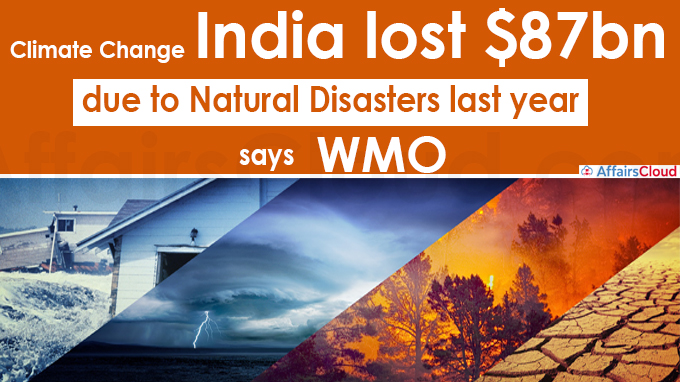 According to the State of the Climate in Asia 2020, a first of its kind multi-agency report published by the World Meteorological Organization (WMO), India has suffered an average annual loss (AAL) of around 87 billion USD due to tropical cyclones, floods and droughts.
According to the State of the Climate in Asia 2020, a first of its kind multi-agency report published by the World Meteorological Organization (WMO), India has suffered an average annual loss (AAL) of around 87 billion USD due to tropical cyclones, floods and droughts.
- China experienced the highest ALL of around 238 Billion USD followed by India and Japan (83 billion USD).
- The highest AAL was associated with drought.
State of the Climate in Asia 2020:
i.The report provides an overview of land and ocean temperatures, precipitation, glacier retreat, shrinking sea ice, sea-level rise and severe weather.
ii.The report also examines the socio-economic impacts in a year when the region is also affected by the COVID-19 pandemic.
iii.The report covers every affected region of Asia, from the Himalayas to the Coastal areas, densely populated areas to deserts from the Arctic to the Arabian seas.
Highlights of the report:
Temperature:
In Asia, 2020 has been recorded as the warmest year with a mean temperature of 1.39 degree Celsius above the 1981-2010 average.
- The heat extremes include a temperature of 38.0 degree Celsius at Verkhoyansk, Russian Federation, provisionally the highest known temperature anywhere north of the Arctic Circle.
Precipitation:
The East Asian and South Asian summer monsoons combined with the frequent tropical cyclones, caused floods and landslides, leading to the loss of life and displacement in many countries across Asia.
Ocean warmth:
Sea-surface temperature (SST) is an important physical indicator of Earth’s climate system.
In 2020, average sea surface temperatures reached record high values in the Indian Ocean, Pacific Ocean and the Arctic Ocean.
Sea level:
The global average sea level has risen at a rate of 3.3 ± 0.3 mm per year since the early 1990s.
Glacier retreat:
High Mountain Asia is home to approximately 100000 km2 of glaciers centred on the Tibetan Plateau and Himalayas. This accounts for the largest volumes of ice outside of the polar regions and is the source of 10 important Asian rivers.
- The glacier mass is projected to decrease by 20 to 40% by 2050.
Impact of extreme weather:
According to the Economic and Social Commission for Asia and the Pacific (ESCAP), Tropical cyclones, floods and droughts induced an ALL of several hundred billion dollars.
- Considering the size of the economy the AAL is expected to be as high as 7.9% of GDP (7.5 billion USD) for Tajikistan, 5.9% of GDP (24.5 billion USD) for Cambodia and 5.8% of GDP (17.9 billion USD) for the Lao People’s Democratic Republic.
Population Displacement:
China, Bangladesh and India have recorded much of the disaster-related displacement (around 4 to 5 million new displacements each) that took place in 2020.
- Cyclone Amphan, one of the strongest cyclones ever recorded, hit the Sundarbans region between India and Bangladesh in May 2020 displacing 2.4 million people in India and 2.5 million people in Bangladesh.
Agriculture and Food Security:
Compared to 2019, In 2020, the number of undernourished people has increased 6% in South-East Asia and West Asia, and by 20% in South Asia.
- In 2020, 48.8 million people in South-East Asia, 305.7 million in South Asia and 42.3 million in West Asia, were estimated to have been undernourished.
Sustainable Development Goal:
Most of the subregions of Asia has regressed on the Sustainable Development Goal 13: Climate actions. These regions will miss the SDGs unless they make an effort are accelerated to build resilience.
Click here for the complete report
Recent Related News:
The World Meteorological Organization (WMO) released a report on the latest climate science information named ‘United in Science 2021’.
- As per the report, the COVID-19 caused only a temporary decline in carbon dioxide (CO2) emissions in 2020.
- Whereas the concentrations of major greenhouse gases – CO2, methane (CH4) and nitrous oxide (N2O) in the atmosphere continued to increase in 2020 and the first half of 2021.
About World Meteorological Organization (WMO):
WMO is an intergovernmental organization with a membership of 193 Member States and Territories.
Secretary-General– Petteri Taalas
Headquarters– Geneva, Switzerland




